Juneero was one of a small group of mechanical construction sets which involved the actual cutting and shaping of metal (others were N-G-Neero and Prestacon). It also included some prefabricated parts, such as gears, wheels, and tyres. By way of contrast, sets such as Meccano® generally involved the assembly of pre-made parts; although you could bend them within limits, you didn't actually fabricate parts in normal use. None of these "fabrication" sets such as Juneero were commercially successful.
Juneero seems to have been patented by 1936 (application filed 1934) in England by Otto Rudolph Opperman (with later patents by Stanley Edward Opperman, who by the patent record seem to have been a prolific inventor generally). It was mentioned as "new" in Model Engineer in 1941 (see bibliographic notes below). It seems to have disappeared by the early 1950s.
It was made in England by Juneero, Ltd. and in Canada by The Steelmaster Company Limited, Vancouver.

"How to Use Juneero"
A single sheet of instructions, double-sided. Published in England, probably between 1936 (the date of the O.R. Opperman patent) and 1941 (the date this product was reviewed in Model Engineer).
Through a Kafkaesque labyrinth of copyright legislation, this document is probably now in the public domain in England, but is in copyright in the US (even though it is likely that no one owns this copyright); see the "legal notes" section at the bottom of this page for further discussion. I cannot therefore reprint it here (I'm located in the US). However, following this copyright labyrinth further, it turns out that it is in the public domain in New Zealand. Moreover, New Zealand is also home to an exceptionally good enthusiasts' website devoted to Meccano® and related construction toys: www.nzmeccano.com. With the kind permission of that site, I have been able to host this document there. The (blank) icon links to its presentation on nzmeccano.com. Here is an explicit link to it: http://www.nzmeccano.com/image-58253
There is a lovely set of images of Juneero by Malcolm Hanson on the nzmeccano.com website at http://nzmeccano.com/image-54561 (or navigate: Gallery -> Other Systems -> Juneero).
Two Canadian cultural sites have photographs of the Canadian version: The Emily Carr University of Art and Design, Museum: http://bc150.ecuad.ca/museum/09_06.html and The City of Vancouver Archives: http://searcharchives.vancouver.ca/juneero-engineering-kit-for-children-produced-by-steelmaster-co-ltd;rad
I was fortunate enough to rescue a basic Juneero tool. It lacks all accessories (except the gauge rod), ancillary materials, packaging, literature, and accessories (except the gauge rod). Still, I'm glad to have it. Here are some pictures of it:
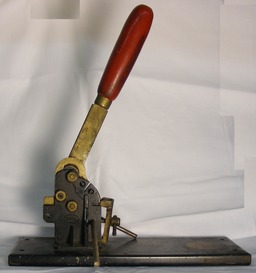
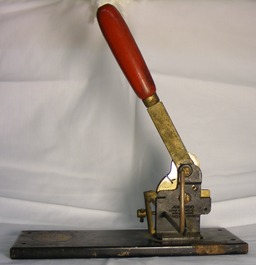
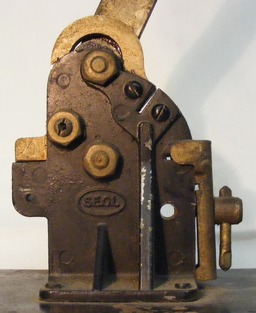
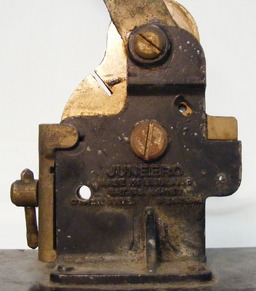
I don't know for certain what "S.E.O.L." might stand for, in the photograph above left. One possibility might be "S[tanley] E[dward] O[pperman] L[imited]" (see the patents, below), but I'm just guessing at that.
The text on the photo above right reads "JUNEERO / MADE IN ENGLAND / PAT. No. 411157 / OTHER PATS PENDING

The label shown above is pasted to the underside of the base.
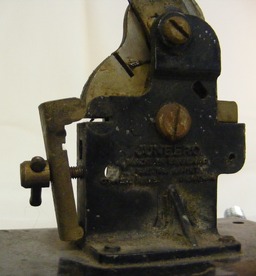
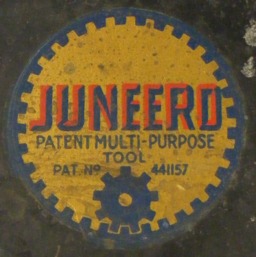
The supplied die was 6BA { ME 4261 } and the standard thread was also 6BA { Kevin Steele}.
The 1941 reviewer in Model Engineer { ME 2070} gives the rod diameter as 1/8 inch. But { Kevin Steele} gives the rod diameter as 0.104 inch (from his research, I believe, not from examination of materials). A quick search online indicates that a 6BA thread has a diameter over the thread of 0.11 inches, which splits this difference :-)
The strip width was 3/8 inch, and the angle width was 3/8 by 3/8 inch { Joseph Preston} and { Kevin Steele}.
Strip thickness was 0.028 inch, in soft mild steel (or one could use aluminum) { Kevin Steele}.
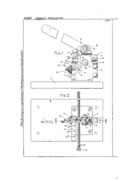
GB Patent 441,157 (O.R.Opperman, 1936)
British patent 441,157, "Improvements in or relating to Hand-operated Tools for Shearing, Bending or Punching Metal." Granted to Otto Rudolph Opperman. Complete Specification Accepted: 1936-01-14. Application Date: 1934-11-16, application no. 33063/34.
This would seem to be the basic "Juneero" patent.
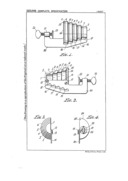
GB Patent 525,040 (S.E.Opperman & J.Harrison, 1940)
British patent 525,040, "Improvements in or relating to Tools for Bending Metal." Granted to Stanley Edward Opperman and John Harrison. Complete Specification Accepted 1940-08-20. Application Date: 1939-02-13, application no. 4658/39.
This tool is illustrated in Jeff Dowden's letter to the editor in Model Engineer No. 4278 .
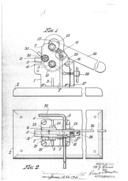
CA Patent 411,968
Canadian patent 411,968. No title. Granted to William James Rand. Signed 1941-06-18.
This would seem to be the basic "Juneero" patent (O.R. Opperman's 1934/1936 GB patent 441,157) re-done for the Canadian market under the name of Rand (see also GB patent 543,553, below, in the names of Juneero Ltd. and Rand).
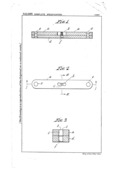
GB Patent 542,965 (S.E.Opperman & Juneero Ltd., 1942)
British patent 542,965, "Improvements in and relating to Screw-cutting Dies." Granted to Stanley Edward Opperman and Juneero Limited. Complete Specification Accepted 1942-02-04. Application Date: 1940-07-01, application no. 11104/40. This would appear to be the screwcutting die "supplied with deluxe model only" (see "How to Use...", above). No mention is made of its use in a toy, however. 1941 was perhaps not a good time to be patenting toys in England. ( Malcolm Hanson, on nzmeccano.com suggests that Juneero, Ltd. was able to keep Juneero in production during the Second World War by "marketing it as an engineering training system.")
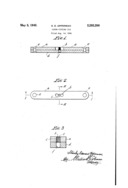
US Patent 2,282,206 (S.E.Opperman, 1942)
US patent 2,282,206, "Screw-Cutting Die," issued 1942-05-05 to Stanley Edward Opperman. Filed 1941-08-14 as application serial number 406,913. Filed in Great Britain 1940-07-01.
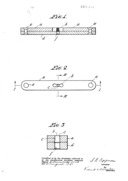
CA Patent 411,588 (S.E.Opperman, Filed 1941)
Canadian patent 411,588. No title. Granted to Stanley Edward Opperman. Signed 1941-08-21.
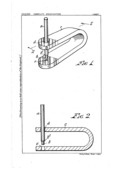
GB Patent 543,553 (Juneero Ltd. & W.J.Rand, 1942)
British patent 543,553, "An Improved Punching Tool." Granted to Juneero Limited and William James Rand. Complete Specification Accepted: 1942-03-03. Application Date: 1940-11-11, application no. 16331/40.
I don't know if this item was a part of the Juneero Multi-Purpose Tool construction system.
I am indebted to Bill Phillips' "Model Engineer Index" data ( http://www.groundlevel.demon.co.uk/me_index.html) and to the interactive version of it at http://www.itech.net.au/modelengineer/ for the basic references here. For those issues which I have been able to consult, the additional comments are my own.
It would seem that Juneero was first mentioned in Model Engineer in 1941. What is more interesting is that there seems to have been a complete lack of notice of it from 1949 through 1992.
1941-01-09. Model Engineer. Vol. 84, No. 2070. pp. 35-36. Anon. "'Juneero': A New Method of Constructional Modelling." This is a new-product review. It is illustrated with photographs (probably from Juneero, Ltd.) showing the operations of shearing steel strip, setting the gauge, bending strips to right angles, punching holes in strips, and cutting threads with the die (using the vise attachment). It refers to the rod size as 1/8 inch (in steel) and the strip width as 3/8 inch (again, in steel). The reviewer also points out that while accuracy is "built in" to the hole spacing of prefabricated construction sets, with Juneero "accuracy is in the hands of the user." The reviewer considers this to be an advantage. Note: Vol. 84 of Model Engineer was re-issued in facsimile by Argus Books, Ltd. in 1977. ISBN: 0-85242-578-3. [DMM]
1947. Model Engineer. Vol. 97, No. 2411. p. 139. Anon. [Mentioned in the Trade Stands notice for the 1947 Model Engineer Exhibition.] [NOT YET CONSULTED]
1948. Model Engineer. Vol. 99, No. 2464. p. 159. Anon. [Mentioned in the Trade Stands notice for the 1948 Model Engineer Exhibition.] [NOT YET CONSULTED]
1949. Model Engineer. Vol. 101, No. 2515. p. 133. Anon. [Mentioned in the Trade Stands notice for the 1949 Model Engineer Exhibition.] [NOT YET CONSULTED]
1949. Model Engineer. Vol. 101, No. 2533. p. 739. Anon. "The 'Juneero' Electric Engraver." [NOT YET CONSULTED]
1992. Model Engineer. Vol. 169, No. 2930. p. 439. Philipson, J. "A Magic Tool" [Juneero found in a junk shop] [NOT YET CONSULTED]
1998. Model Engineer. Vol. 180, No. 4065. p. 440. Calder, John. "Who Remembers Juneero?" [NOT YET CONSULTED]
1998. Model Engineer. Vol. 180, No. 4069. p. 678. "Tooling." / "Who Remembers Juneero?" [NOT YET CONSULTED]
1998. Model Engineer. Vol. 181, No. 4072, p. 72. [recollections of Juneero by Dr. Bernard Hayes] [NOT YET CONSULTED]
1998. Model Engineer. Vol. 181, No. 4075, p. 273. [Mentioned in an article by Keith Wilson.] [NOT YET CONSULTED]
1998. Model Engineer. Vol. 181, No. 4077, p. 368. [recollections of Juneero by Peter Bennett] [NOT YET CONSULTED]
1998. Model Engineer. Vol. 181, No. 4078, p. 430. [recollections of Juneero and N-G-Neero by David Hobson] [NOT YET CONSULTED]
2005-09-02 Model Engineer. Vol. 195, No. 4255, p. 251. In the Post Bag column, Peter Spenlove-Spenlove writes of discovering some corrugated sheets that he believes are Juneero. [DMM]
2005-11-25. Model Engineer. Vol. 195, No. 4261, p. 611. In the Post Bag column, David Nunes says that Peter Spenlove-Spenlove's corrugated material is not from Juneero, and provides his reminiscences of the machine. He recalls it as using a 6BA die to thread the rod. Photograph of a Juneero tool and box. [DMM]
2006-01-06. Model Engineer. Vol. 196, No. 4264, p. 15. In the Post Bag column, Joseph Preston shares a photograph of his well-used and well-loved Juneero tool, purchased in 1937. [DMM]
2006-01-20. Model Engineer. Vol. 196, No. 4265, pp. 74-75. In the Post Bag column, C. Eastham syas that Peter Spenlove-Spenlove's corrugated sheets are indeed Juneero parts, although not those intended to be bent using the tool. He supplies a few other details. [DMM]
2006-03-03. Model Engineer. Vol. 196, No. 4268, p. 250. In the Post Bag column, D. M. Rickets asks where he might purchase a Juneero outfit. [DMM]
2006-07-21. Model Engineer. Vol. 197, No. 4278. p. 75. In the Post Bag column, Geoff Dowden provides many details of Juneero, and illustrates his own outfit (including the circular bending tool described in GB patent 525,040) and a flyer for a "Juneero Designers Contest." [DMM]
Malcolm Hanson has written an excellent article, "Juneero, the Do-It-Yourself Meccano," which appeared in Constructor Quarterly , No. 91 (March 2011).
Juneero has been mentioned in at least six issues of the Other Systems Newsletter: http://www.osnl.co.uk
There was a discussion of Juneero on the "rcgroups" forum at http://www.rcgroups.com/forums/showthread.php?t=80045. In this discussion, Kevin Steele (citing in turn sources from Model Engineer) gave several specification details for Juneero.
The photographs of a Juneero Multi-Purpose Tool on this page were taken by the author and are placed by him in the public domain.
"How to Use Juneero" was published in Britain in the late 1930s or very early 1940s. It would have passed into the public domain in England 50 years from the date of its initial publication. It was therefore probably in the public domain in England from the late 1980s through 1995-12-31. On 1996-01-01, English copyright would have been restored to it for a period of 70 years from its initial publication, putting it back in copyright. It is likely, but not entirely certain (as it is undated) that this copyright period has now expired in England. In the US, since its publication did not comply with US copyright formalities at the time, it was in the public domain from its date of publication through 1995-12-31. However, the restoration of its copyright on 1996-01-01 corresponded to the US implementation of the Uruguay round of GATT, which placed foreign documents in copyright at that time in their home countries in copyright in the US for the maximum possible period (currently 95 years from date of publication). Copyright term in New Zealand for anonymous works is 50 years (not 70) from the date of publication, so this work is clearly in the public domain there.
US patent specifications are in the public domain by law.
British patent specifications published before 1989-08-01 were subject to Crown copyright for a period of 50 years. This period was not extended in the 1996 extension of other GB copyright periods to 70 years. Crown copyright in Great Britain has expired for all of the GB patents reprinted here. They are therefore in the public domain in Great Britain. All of the GB patents here were in the public domain through expiration of Crown copyright before 1996, so the 1996-01-01 US implementation of the Uruguay round of GATT, which placed foreign works in copyright in their own countries on that date in copyright in the US, should not apply to them I believe that they are therefore in the public domain in the US.
(In any event, the (UK) Copyright, Designs and Patents Act of 1988, Section 47(3) allowed the "appropriate person" to authorize the dissemination of documents of "general scientific, technical, commercial or economic interest" without copyright infringement. The (UK) Comptroller of Patents authorized this for UK patents in the Official Journal of Patents, 6 March 1991. So even if these patents were still in copyright in the US (though I believe that they are not), their dissemination under these terms would be authorized.)
According to the "Canadian Public Domain Flowchart" prepared by Creative Commons Canada, published Canadian works subject to Crown Copyight entered the public domain at the date of publication plus 50 years. The Canadian patents reprinted here therefore entered the public domain in 1991, and were not subject to the new imposition of US copyright in 1996. They are therefore, I believe, in the public domain in the US.
All portions of this document not noted otherwise are Copyright © 2012 by David M. MacMillan and Rollande Krandall.
Circuitous Root is a Registered Trademark of David M. MacMillan and Rollande Krandall.
This work is licensed under the Creative Commons "Attribution - ShareAlike" license. See http://creativecommons.org/licenses/by-sa/3.0/ for its terms.
Presented originally by Circuitous Root®
Select Resolution: 0 [other resolutions temporarily disabled due to lack of disk space]